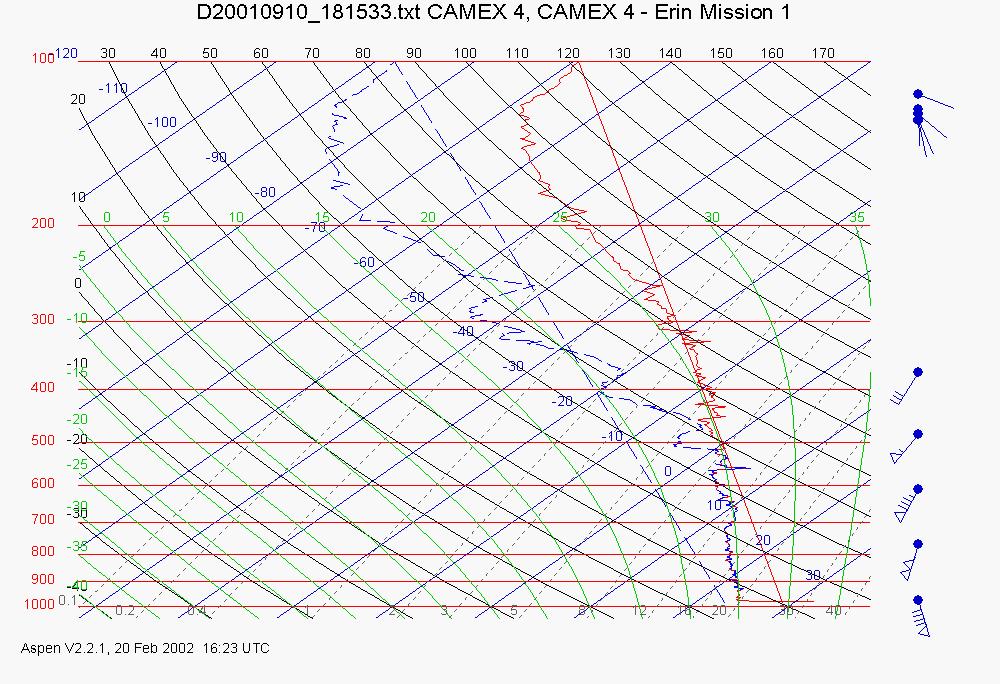CAMEX-4 ER-2 High Altitude Dropsonde (EHAD)
Table of Contents
Introduction
The ER-2 Hight Altitude Dropsonde (EHAD) system uses Global Positioning System (GPS) dropwindsondes to measure vertical profiles of pressure, temperature, humidity, and wind during descent to the surface. CAMEX-4 was EHAD's first operational deployment. A total of 25 sondes were released.
Vertical measurement of the atmosphere goes back many decades with the current dropwindsonde coming into being in 1993. Working in collaboration with the National Oceanic and Atmospheric Administration/ Atlantic Oceanographic and Meteorological Laboratory (NOAA/AOML) and the German Aerospace Research Establishment (DLR), the National Center for Atmospheric Research/ Atmosphere Technology Division (NCAR/ATD) developed a third-generation dropwindsonde using a new sensor module and a GPS receiver from Vaisala, Inc. More accurate wind profiles are now available because of a NCAR/ATD-developed, unique square-cone parachute that reduces the initial shock load and stabilizes the dropwindsonde as it falls. The dropswindsondes are the responsibility of NCAR/ATD/Surface and Sounding Systems Facility who provided the final post experiment quality control processing.
These sondes were further modified to operate from the newly developed EHAD system. Capable of carrying up to 17 sondes in a special pod mounted ventrally on the centerline of the ER-2, the system promised to provide sounding data from an altitude never before obtained in the tropical storm environment. Unlike sondes released from the AVAPS system, sondes are mounted in the EHAD pod are automatically selected and preflighted. Launch is commanded by the ER-2 pilot, and the sonde is spring ejected from the pod. Launched at approximately 20km (65,000ft), the sonde takes almost a full thirty minutes to reach the surface. .
The GPS dropsonde page at ATD at http://www.atd.ucar.edu/sssf/facilities/dropsonde/gpsDropsonde.html contains details about the sonde itself, and the EHAD system.
Content and structure of the EHAD files
There are twofiles associated with each dropwindsonde released during the experiment: an image of the sounding, a QCed data file, and finally the World Meteorological Organization (WMO) code file (discussed below). These three files are 'tarred' into a daily/mission file with the following naming convention: c4eehad_2001.ddd_01-mmm.tar where c4eehad is the designator for the ER-2 High Altitude dropsonde data, 2001.ddd is year and day of year, 01-mmm where mmm is the ER-2 sortie number, and tar indicates 'tar' file.
Once 'untarred' there will be two files whose naming convention is very straightforward. Images (in .jpg format) are named Drop#_hhmmss.jpg where the # is the release sequence number and hhmmss is the time of the drop. The other file is the QCed sounding with data in tabular form. This has the file name in the form Dyyyymmdd_hhmmss.QCcls, where D identifies this as data, yyyymmdd is year month date (e.g. 20010908) and hhmmss is the release time in hours, minutes and seconds, and QCcls is for the QC data file in CLASS format.
Browse Images: Drop#_hhmmss.jpg
The suffix '.jpg' identifies this browse image as a plotted sounding in JPG format. The skew-T diagram shows the temperature, dewpoint, and vertical wind profiles measured during the flight of the dropwindsonde. Date, time of release, and mission ID are given in the title of the image. An example of the browse image named Drop5.jpg is shown below:

QC data file: d20010910_155810.QCcls
A sample is shown here. Data is in CLASS format- click here for more information. For the purpose of this document, this data has been formatted so that lines are not broken. One simple way to obtain neatly aligned data is to import the raw data text file into a spreadsheet (e.g. Excel) for automatic formatting.
Close examination will reveal that the file reads backwards in time from the top of the file to the bottom, consequently pressures decrease from top to bottom making it appear to be a surface sounding. This is the data file as it appears following quality control by NCAR. Otherwise, the file is self explanatory.
Contact Information
To order these data or for further information, please contact:
Global Hydrology Resource Center
User Services
320 Sparkman Drive
Huntsville, AL 35805
Phone: 256-961-7932
E-mail: support-ghrc@earthdata.nasa.gov
Web: http://ghrc.nsstc.nasa.gov/
|

